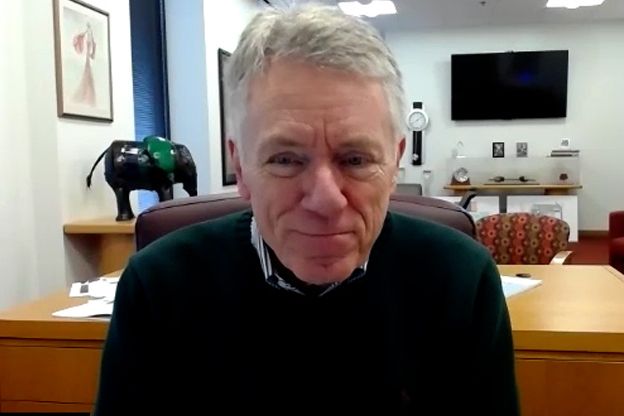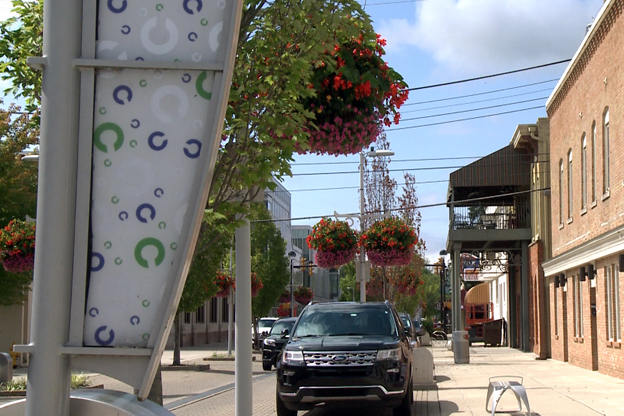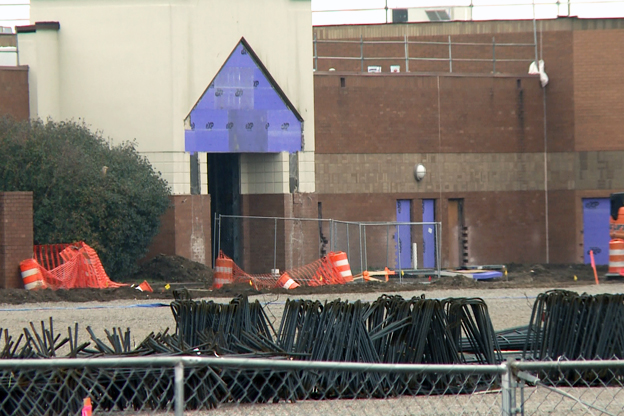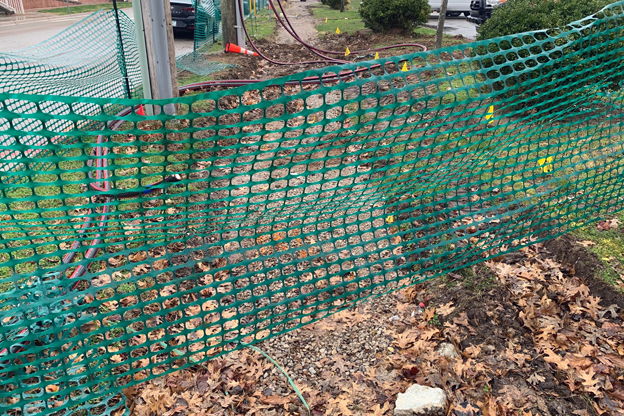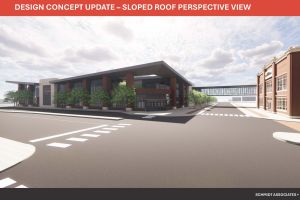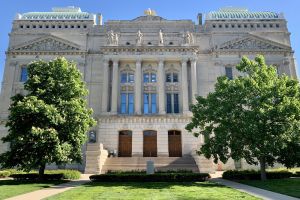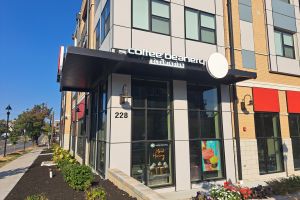Hello and welcome to ask the mayor on WFIU. I'm Joe Hren. First week of February. As always, we're in Columbus, this time on Zoom with Mayor Jim Lienhoop at City Hall. Hello, welcome. Also happy new year. I didn't get to see you in early January.
Unknown Speaker
Yeah. Well, welcome again, back to Columbus, even though it's virtually or electronically, but But yeah, in early January, my wife and I were taking our son back to New York City. And so we were not able to, to meet up and so glad to be back here. Even though it's still January, we're now prepared for February. Right. And it's the month that we're talking about. So so yeah. Good. Good to be here.
Unknown Speaker
Again, thanks. Appreciate your time. Let's just start with one of the point out I hate to start the show this way. But it's just the nature of reality that cause for concern there in Columbus and care, though to 200 Columbus residents reported stood against Asian hate after the Bloomington transit transit incident recently, you know, great sign of support of a neighboring community. It's something we say all the time. You know, it's just the beginning of what needs to be done, though. Right.
Unknown Speaker
Right. You know, Columbus and Bloomington are a lot alike. In many respects, you take the students away from Bloomington, we're really close to the same size. And so we've got a lot in common, and the people who live here felt a loss with with with respect to what happened in Bloomington, and maybe a trite phrase, but we share the pain, if you will. And so it was important to us to, to recognize that. And to add our voice to the concern, you know, that had been expressed not only with respect to what happened in Bloomington, but, you know, just a few days prior to that there had been an incident out in Los Angeles, that had targeted an Asian, a nightclub, I believe, I think, gathering place. And so again, we want to let people know that we do care about everybody's safety, and particularly those who maybe are new to this country, or maybe their families if they're slightly different ethnicity, or skin color or accent, whatever, might make them a little bit different than mainstream. folks like you and me. So So yeah, we wanted to take the opportunity to have that discussion. And, and I thought it was very well attended. I was kind of surprised that we had that many people there. But but we did and, and so like I say it, I thought spoke well for our community and was glad to be able to host it.
Unknown Speaker
And now, you know, we're dealing with the deadly beating of Tiree nickels. And I see you are part as many mayors and officials and a statement that was released about that as well.
Unknown Speaker
Correct. And once again, you know, we wanted to add our voice to, to those of us that have others that just make it clear that there is no place for this kind of activity in our society in a civilized society. And once again, want people to understand that we are committed to training police officers and training others, that you don't behave this way. That there there are other ways to go about what you want to do that don't resort to violence that don't leave the people incapacitated, or, you know, near death. And so that's what happened to this young man, and I just couldn't feel worse about it. It is something that we try hard to avoid and to see that it happened and, and it it happened in a city that I want to say Memphis is 600,000. So they're 1011 times bigger than Columbus all times larger. Now, they should have a consistent police program that's consistent with with that size, and they just did and and that's really discouraging. So once again, wanting to let people know that we do care, and that we want to speak out against that kind of activity. I'll meet tomorrow. I've got a meeting with Sheriff lane, and Bartholomew County Sheriff Chris lane. And that will be one of the topics of conversation, you know, just have we done everything we can do to try to address something like that before it happens, you know, in our community.
Unknown Speaker
One of the follow up briefly on the downtown fire we covered that was back in December has been ruled I believe, still undetermined. So there was no official cause to that fire.
Unknown Speaker
No official known correlate cause correct. And that was really a result of the destruction that had occurred to the investigators who would have otherwise gone in there and tried to determine the cause. Were not safe. And so Though they they declined to enter and reported that, what do you mean, we'll call that declination to the Indiana State Fire Marshal that agreed that there was no real need, in this case to do any further investigation, I drove by there at lunchtime today. And I would sit, I would estimate, about a third of the building is down. The third of it that is closest to the remaining structure that used to house the Chamber of Commerce. So, you know, we had, you know, tried to encourage the owners to to get busy, you know, with respect to the demolition of that building, because we believe that it was a safety hazard for anybody who might walk or drive along history, or Franklin Street, much less the alleys in that area. And so I'm really pleased to see that they've made some progress. And hopefully, at the rate they're going, there'll be done here within a couple of weeks. Because what we want to do is reopen the streets in the alley. So it's just a Fifth Street in that area is an important traffic Avenue or traffic lane, it's a couple of lanes for us. And the deliveries facilitate, excuse me the alleys to facilitate deliveries, trash pickup, and so forth that, you know, have been hampered by, by the closure. So, so yeah, I'm hopeful within a couple of weeks, we'll be back to business as normal.
Unknown Speaker
I see a few streets down from fifth around second, the city's looking to add some as it parking and traffic calming devices, right, what's needed there. And why?
Unknown Speaker
Well, there's a couple of things going on. One is that we have had a few accidents near the jail, if you're familiar with the downtown area here in Columbus, the jails, sits on Second Street, and the predominant parking for the jail is across Second Street. So we've got a need for visitors to the jail to cross the what is the three lanes of State Road 46, all headed in the same direction. And it's just a challenge for for anybody who wants to do that. So we've had conversations for a while, in terms of traffic calming devices, we've talked about a hawk signal, some way to stop traffic, you know, with a pedestrian, you know, presses a button. And we have in the plans that we have and hope to be able to build a hotel conference center on that block, you know, the Indiana Department of Transportation has been reluctant to spend the money that would be would result in a a hawk signal. So you know, we, we've backed away from that. And now we're taking a look at a way to try to, like we say calm traffic. And you know, the traffic engineers tell us a couple of things. One is that if you design a two or three lane road, where the lanes are 12 or 14 feet wide, and you can look forward and see a mile that looks an awful lot like an interstate. And people tend to drive to the environment that they're in, maybe we would like for them to drive to this posted speed limit. But sometimes they don't do that. And even though this past is right in front of the jail, the sheriff's department and our police department, it's not always easy for us to patrol the area. And so one of the preserved or one of the suggested solutions is to calm the traffic to, to change that vision, you know, so that that's not what you see, as you're driving down through that, that thoroughfare and among the ways to do that are to narrow the lanes, you know, get something down now where it's going to be a problem, we probably still maintain 112 foot lane, because we do get a bunch of truck traffic, and the occasional oversized, oversized load, you know, on that on that street, but but to narrow the lanes and to provide for on street parking. And again, this will, you know, just sort of change the visual effect that you get when you're driving down through there. And we think that that will be instrumental in getting people to slow down. We also talk about what's called bump outs. And so at the various corners, you may push the curb, if you will, out a lane on either side. So that those pedestrians who want to cross don't have quite as much pavement to cover. I mean, you know, they've, they start out at one lane into the road, so to speak before they have to get off the sidewalk. And it's all designed to try to slow traffic down and make it a little bit more a little bit safer for pedestrians and and that's what we're talking about. And a part of this came about when we had our Envision Columbus process that we completed this point maybe three years ago, four years ago. And the whole notion was to try to slow traffic on second and third streets. And part of that emphasis emphasis there is to enhance retail. You know we don't have a lot of retail going on right now on either of those, but we would like to have some. And so part of what we want to do is to create an environment that's conducive to that. Excuse me at the same time, the conversations that we had, with a hotel developer indicated a desire also for a calmer traffic. And if you think about it, it just makes sense in terms of having a look, I'll tell you a pull off or pull back on, you know, a place where somebody who's coming up to unload their luggage can get off the roadway and get their luggage off and then get back on the roadway without getting tied up and much traffic. And so we want to try to be receptive to those kinds of thoughts and, and that's really what's put what's behind trying to slow down the traffic there on Second Street. We don't have a program yet for third, but that should follow within a couple of months,
Unknown Speaker
or their designs and so forth, ready to go for second street or just just still in discussion right now?
Unknown Speaker
We've got a few are, we've got some thoughts, I hate to call them designs. But But yeah, we've we've got folks in the engineering department, we've got a couple of PAs on staff here. And they've sat down and said, Well, you could do this, or you could do that. And what we really need is somebody who studies the spends their, you know, their full time efforts at trying to manage traffic and traffic flow to sort of help us understand, you know, what, what really makes the most sense, you know, in this case, and so, so yeah, we've hired an engineering firm that will will do that. And hopefully they report back to us in short order, and will we then we have to approach the Indiana Department of Transportation, because even though we call it second street, and we refer to it as a city street, it's a state highway. And so they have jurisdiction, you know, about what happens there. But in our preliminary conversations with them, they've been supportive of what we want to do they kind of get the notion that, yeah, it's, it's a little dangerous for pedestrians, and it's a little bit of an impediment to the what we would consider to be the investment that we want private industry to make in that area.
Unknown Speaker
And I know we've talked about it, it would be called a committee or commission, we're looking at parking downtown to and heard about reduced parking enforcement. But I don't know the context that's in do you have anything on that?
Unknown Speaker
Well, yeah, we have taken a look at we've been looking at that I'm sure it's no different in a lot of other communities. But parking, downtown parking has been a topic of conversation for decades, you know, and for decades, we thought, Well, what we needed was a parking garage. And that would be the solution. Well, now we've got three parking garages, and we're still talking about downtown parking. Now the environment has changed considerably. With the pandemic, you know, we just don't have the downtown traffic that we we had at one time. But pre pandemic, we found ourselves in a situation where, you know, there were folks who were just going to park downtown, and it didn't matter to them what the sign said or what the fine was made, that's just what they were going to do. And, you know, we're really kind of reluctant to get in there and, and either boot cars or tow them. But, but we felt like that's what we were where we were heading. We didn't get we never went there. And part of the reason was that the pandemic came along and kind of reduced the demand for parking in the garages or on the street. And we find ourselves today in a situation where we believe, based on, you know, anecdotal evidence and some observations, that we don't have quite the turnover in parking that we would like on Washington Street. And that seems to be the focus of our attention minutes where the majority of the merchants are. And, you know, the people who have noticed that there's, there isn't a turnover that they would like to make. I don't know what the, you know, the average length of stay is for a shopper in a store, or a shopper in an area. If you go to the mall, how often do you How long do you stay before you get back in your car and go out maybe a visit to three stores. And so we want to try to have a comparable experience in the downtown area. And so we've begun to think that well, we'll focus on Washington Street, and begin to reinforce maybe a little bit more strictly the parking there and in return, the trade off will be that we will no longer restrict over on Franklin Street or Jackson Street, you know, some of the block off, you know, the edges of the downtown area. And we'll just give that a chance to see how it works. And, you know, before we before we decide to do anything further, because that we had conversations about parking meters, and pocket parking kiosks, and it's similar to what I've seen in Indianapolis or in Bloomington. And I just don't know that we're quite prepared to go there yet. There's a significant investment associated with those. Not sure that it pays it's just something you do because you desire the effect. But before we get to there, we're going to try this stopgap measure and see how, see how that works. So hope would get the answer we're looking for, which is a little more of a turnover on Washington Street and keeps keeps everybody happy with respect to the amount of time they can spend in the retail area we got downtown.
Unknown Speaker
And just to be clear, it's, as you said, No meters downtown, but you have a is it a two hour limit? 333 hour limit downtown Columbus. Okay.
Unknown Speaker
What should I, you know, should be planning? I mean,
Unknown Speaker
yeah, to shop to eat to walk around, and then let's let someone else come in and do the same. Yeah. Well, let's get to next Park. I know, construction is ongoing. You've been hinting the last few months to wait till February, I think, because you're gonna see a lot of steel that's on the way.
Unknown Speaker
It's coming. Everything I get a little frustrated. I think everything should be done yesterday, but but we're going to have an event on February 8, late morning, I want to say 11am. But I could be mistaken as to the specific time, but it's on February 8, in that approximate approximate timeframe, you know, I commented, we typically get when we do a project at the start, there'll be a groundbreaking and you know, you get out there with a what looks like a silver plated shovel. It's not silver, but it is shiny, and you dig a hole in the ground or you get a shovel full of sand or gravel and and so that's typically how we we start these projects. And so I've wanted to amass a collection of shuffles, you know, I felt like that would be a great way to sort of mark my tenure here as mayor but, but at any rate, this this particular project, we're going to be doing some interior demolition, to make way for some community rooms in our parks, department offices, and so forth. So instead of shovels, we chose sledgehammers. And so instead of a shiny shop, where we're going to have a shiny sledge, and those who are, you know, show up will be given an opportunity to take a whack a hat. You know, what, what had been part of the wall in the JC Penney space there at the common art Nexus Park. So, so yeah, February 8, will be our next milestone date, so to speak. And yes, we, you know, the contractors have been pouring their footers, or footings, whatever the appropriate word is. And it's a fair amount of concrete going into the ground and preparation of steel erection. And I'm told that that will happen, either later this later February, late February, or the first of March. So, so yeah, so we're going to be able to see, see something poking out of the ground here real soon and pretty excited about it.
Unknown Speaker
But also, City Council's busy looking ahead, to be able to fund full time positions, employees that are going to run that facility as well, right? Yes, you
Unknown Speaker
know, our belief is that once Nexus Park is up and running, and you know, I use the word mature, I don't know if that's exactly appropriate. But once we filled the the rental space, to the extent that we can, we think we're confident that the place will pay for the people we hire, to run it, it'll pay for the utilities, and so on and so forth. And as excuse me, in addition to ongoing repairs, and maintenance, and capital upgrades, but there's always a little bit of a get ready or a ramp up, period. And so that's what we're trying to address with this request for appropriation from the city council, we anticipate that we might have to hire four or five people sometime this year, you know, and the timing will vary based upon the construction, how the construction progresses. And it'll vary based upon our ability to find these people. But somebody's going to have to pay them. While we're waiting for the facility to be completed. We need to have them on staff and ready to go so that we can begin to book events and then have them there on day one, we don't want to open the Fieldhouse, for example, on January one of 24, and find out that we're the field house managers and scheduled to arrive until mid February. I mean, that's, that's this isn't gonna work for us. And so we have to hire these people, you know, either in the second or third or fourth quarters of this year. And we and we've been given a lot of advice when people who've done this kind of thing before that, you really do need to have these folks on board at the I wouldn't call it the tail end, but during the construction period, or towards the end of the construction period. So they're just familiar with the facility. I mean, they know where, you know, they know where the restrooms are, the narrower the light switches are, and and we're, you know, some of that infrastructure that's usually behind the walls or in the floors were located. And so we'll start that process. But as everything you know, you can imagine, I mean, it does take some money to sort of get started and that's the reason for the request.
Unknown Speaker
Now, instead of Few minutes left, I wanted to get in the 1821 Trail close to being finished i Here
Unknown Speaker
it is. That's our Bicentennial legacy project. It's going to eventually it will run from the riverfront project to the apartment project on a second Lafayette. But we've got a bunch of markers down there interpretive markers that talk to the history of Columbus that go back to 1821, or maybe even a little earlier, and sort of help understand help people understand you know, why Columbus is here. And in some of the important events that have occurred over the last 200 years. At nighttime, these are lit, and they're quite attractive. Right now. It's a little chilly, you know, to go out there and walk around and take into sight. But once springtime gets her gets a little bit warmer, I'd encourage people to get down there around dusk or a little after, because it's a nice looking presentation. And it really shines at night.
Unknown Speaker
I know we just have about a minute left, but I want to be able to get in the State of the City address coming March 6. So get that into your calendar, right,
Unknown Speaker
march 6. And right now we're looking at March 6 at 6pm. The time may change reflects a little bit, but we're set on the date March 6. And you know, one of the things we'll be able to celebrate is that we are the community of the year, we are really proud that the Indiana State Chamber of Commerce selected Columbus as it's a community of the year. So we're going to do a couple of things. One will be to look backwards a little bit. I mean, as I think we all understand this will be my last State of the City address. So we want to make it a big shindig, as they say, I want people to enjoy themselves and be reminded that we've got a lot done the last seven years and at this point one month resulted in community of the year we've got a few things left on the agenda to finish and so we're, we're gonna get about those but yeah, march 6, or about 6pm. Come on down to the commons and have some fun.
Unknown Speaker
Thank you so much for your time. Appreciate it, and we'll see you next month.
Unknown Speaker
You're welcome. Take care







